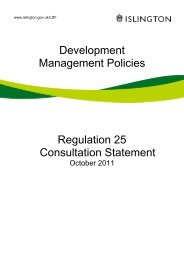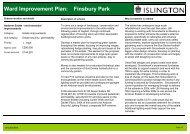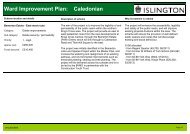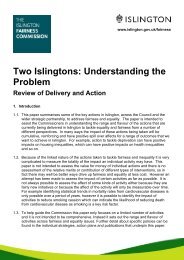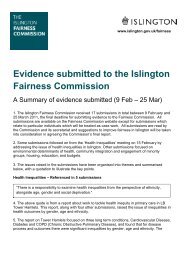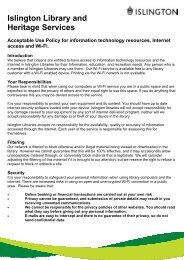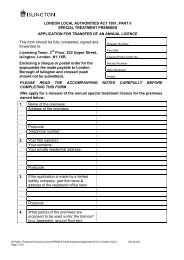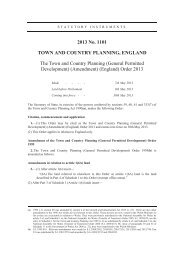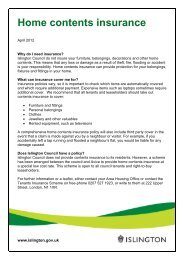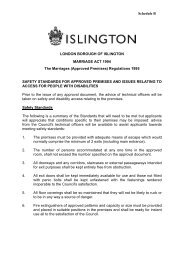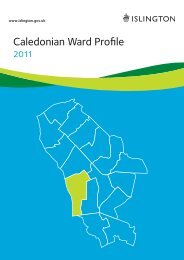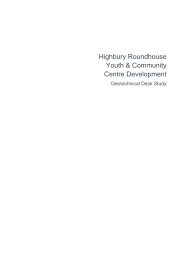Development Management Policies - Direction of ... - Islington Council
Development Management Policies - Direction of ... - Islington Council
Development Management Policies - Direction of ... - Islington Council
Create successful ePaper yourself
Turn your PDF publications into a flip-book with our unique Google optimized e-Paper software.
2 Design and Heritage<br />
2.0.5 Legible developments help people to find their way around both the development and the<br />
wider areas, and understand how a place works. <strong>Development</strong>s that have clear distinction<br />
between public and privates spaces have clear public fronts and private backs <strong>of</strong> buildings,<br />
give clear indication <strong>of</strong> ownership and management responsibility for these spaces.<br />
2.0.6 <strong>Development</strong>s need to consider the surrounding and historic street and block pattern <strong>of</strong><br />
the site to design streets and spaces which enable people to move easily through an area.<br />
In some places in <strong>Islington</strong> older streets patterns have been disrupted by later development<br />
blocking routes and making it difficult to navigate and confusing to move around.<br />
2.0.7 The design and layout <strong>of</strong> buildings must enable sufficient sunlight and daylight to penetrate<br />
into, and between, buildings, and ensure that adjoining land or properties are protected<br />
from overshadowing. To protect privacy for residential developments and existing residential<br />
properties, there should be a minimum distance <strong>of</strong> 18 metres between windows <strong>of</strong> habitable<br />
rooms. This does not apply across the public highway.<br />
2.0.8 Adverse effects on the amenity <strong>of</strong> nearby occupants include any proposed development<br />
which prejudices renewable or low carbon energy supply (e.g. by detrimentally<br />
overshadowing solar panels or interfering with the flow <strong>of</strong> exhaust CHP gases). In such<br />
situations the proposed development should be redesigned to avoid the adverse impacts.<br />
Policy DM 2<br />
Landscape<br />
A. <strong>Development</strong> proposals are a required to take a holistic approach to landscape design<br />
and ensure it is considered as part <strong>of</strong> the whole development. For all developments full<br />
landscape details should be set out in a Landscape Plan submitted with the planning application<br />
(excluding householder applications, changes <strong>of</strong> use, extensions <strong>of</strong> less than 100m 2 and minor<br />
works, where there will be no new units, no intensification and no significant sustainable design<br />
and construction impacts).<br />
Also refer to Policy DM18 (Landscaping and Biodiversity) for detailed design requirements.<br />
Inclusive Design<br />
2.0.9 Inclusive environments derive from an understanding <strong>of</strong> the needs <strong>of</strong> our increasingly<br />
diverse communities and adapt to their different and evolving demands. Inclusive<br />
environments are easily adaptable and functional, they take into account the views<br />
expressed by users and consider the design and management <strong>of</strong> the environment<br />
inextricably linked. Where facilities and amenities are conveniently located, appropriate<br />
and accessible to all, sustainability is enhanced. Multiple and unwelcome, forced and/or<br />
premature moves are also reduced, promoting cohesion, stability and the capacity for local<br />
community development.<br />
12<br />
<strong>Islington</strong> <strong>Council</strong> <strong>Development</strong> <strong>Management</strong> <strong>Policies</strong> - <strong>Direction</strong> <strong>of</strong> Travel



